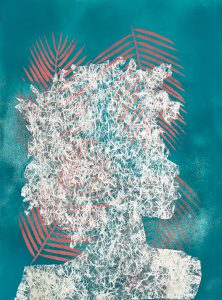
Beginning Thursday, September 26, the UCF Art Gallery exhibition Coalesce explores multiculturalism by Latinx artists, curated by Erika Hirugami. Hirugami is the Founder and CEO of CuratorLove and Curatorial Director at The KNOW Contemporary. The exhibition name comes from how Latin America’s rich cultural heritage coalesces: countless languages, cultural identities, and communities of people who define multiculturalism and defy categorization. Coalesce is a group exhibition that gives voice to the individuals who have hybrid intersectionalities.
Gallery director Shannon Lindsey sat down with Erika Hirugami about the exhibition, Latinx artists and curation.
Shannon Lindsey: How do you explore your role as a curator?
Erika Hirugami: As a Latinx curator, I have personal ties to the subjects that I explore in my practice; as an art historian, I am academically trained to discuss these topics via aesthetic production. Many of my curatorial interests converge creative placemaking and highlight contemporary socio-political concerns. I seek to explore my community’s realities in a respectful way, that can also challenge the hegemonic narrative of this country. My last exhibition, for instance, focused on Latinx labor politics in the U.S. Coalesce explores Latinx categorization, and the intricacies of multiple nationalities, and hybrid intersectionalities creating a single whole. I aim to create a safe space to openly discuss larger concerns that construct yet often systematically oppress the realities of my community.
Lindsey: What inspired you to curate this exhibition that explores Latin American intersectional identities?
Coalesce is in part a self-portrait query, as a Jaxican (Japanese-Mexican) I am constantly challenged with self-defining Latinx with hints of Asian. However, in the great scope of the definition, I find categorization very problematic. Thus, I wanted to explore this and bring forth a statement about hybrid intersectionalities to challenge Latinidad. Abdul Mazid one of the artists in the exhibition is a Syrian-Mexican-American artist who explores the underlying complexities of identity and intersectionality as determined by micro and macro-economic systems within his work; whereas Morel Doucet’s work explores the cultural disparity of self-realization, assimilation, and transnational identity as a Haitian immigrant. As I became familiar with works like the ones featured in this exhibition, I realized this was a larger concern to be addressed, Coalesce opens a space to begin having this conversation.
Lindsey: How did you select the artists you included in the exhibition?
Hirugami: Their artwork defies the inner core of categorization, it speaks to the larger concerns within the scope of this query. I thought it very compelling to highlight works like Kiara Aileen Machado being Latinx and multiculturally Guatemalan, and Salvadoran, whose work is influenced by the complexities of identity and underrepresentation that marginalized communities experience, specifically Central Americans. I sought to collide the artworks featured within the exhibition to bring light to the way in which the structured system of categorization is created, perceived, read, constructed, disrupted, stressed, but ultimately failing Latinx people.
Lindsey: Earlier this year, UCF was designated as a Hispanic Serving Institution by the US Department of Education (serving more than 16,000 Hispanic undergraduate students). How do you see this designation impacting the future of higher education?
Hirugami: While I can commend UCF for being Latinx forward and am very thankful to be able to bring Coalesce to over 16,000 “Hispanic” undergrads. I find language economy to be incredibly important, and not at all being addressed by the Department of Education. Terms like Latinx have emerged because of the lack of inclusivity in terms like “Hispanic” which at its very core highlights systematic oppression. In the most basic definition Hispanic denotes ties to Spain, not all Latinx nations have ties to Spain (some were conquered by France, others by Portugal). “Hispanic” relates to Spanish speaking countries, and also fails to acknowledge the indigenous roots of our mother cultures; Mexico’s Spanish for instance is heavily influenced by Nahuatl (lingua franca of the Mexica (Aztec) empire before the conquest). Furthermore “Hispanic” continues to perpetuate ties with our conquering forefathers, which I am fair certain most people would like to stop being associated with. Terms like “Hispanic” were created to categorize and exclude giant chunks of the population. I hope the Department of Education of a nation made of millions of Latinx people could acknowledge the shortcomings of the language they employ for the sake of the future generations of Latinx. More and more Latinx are receiving a higher education, it would be ideal to have that happen in an inclusive environment that respects their heritage.
Lindsey: For any students who want to pursue a career as a curator, what advice and insight could you share?
Hirugami: For anyone who wants to be a curator I say; welcome to my field, its challenging sometimes, but worth it every day. For future Latinx curators: we work in a nation in which only 3% of our field is made of our community. Meaning that roughly 600 Latinx curators work today in Museums in the US. As per the US Census 56.6 million Latinx live in this country; this roughly translates to each Latinx Curator having to speak for at least 95,000 Latinx. We need more Latinx curators because our truth today is being told by people who don’t understand who we are to begin with.
Read more about Coalesce and RSVP to the opening reception here.
Artwork Image: I am not my hair (Imposter Syndrome) by Morel Doucet, Silkscreen on paper with rice paper, 22.5″x30″, 2019